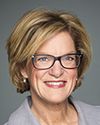The lab being referred to in West Vancouver has been there, as you know, for a very long time. It's one that is somewhat underutilized, as a nice way to put it. We have a significant capacity there that is not being used.
Minister LeBlanc has decided that a key priority for him is to create something we're referring to as science enterprise centres. One of them will be at the Gulf Fisheries Centre in Moncton, the other in the West Vancouver lab in West Vancouver. We expect that there will be substantial new investments in both of those facilities.
Inside the shell of the building, where today you see DFO people exclusively, our expectation is that in West Vancouver, for example, we will probably see people from the Vancouver Aquarium, from the province, and from the University of British Columbia. Actually, UBC people are already there now. We're going to expand our presence there in a significant way and try to bring Canadians more into touch with the science they fund and to create space for people, in that community and its surrounding areas, to interact with the science that we're producing, but with scientists overall.
We think this is an innovative way of doing business generally. We're going to look at it in those two centres. We really think this is going to bring us much more directly into contact not only with people in British Columbia but to some considerable degree in both Moncton and West Vancouver. We're going to bring the science community to those two places, but we're also going to bring those two places to the science community.




